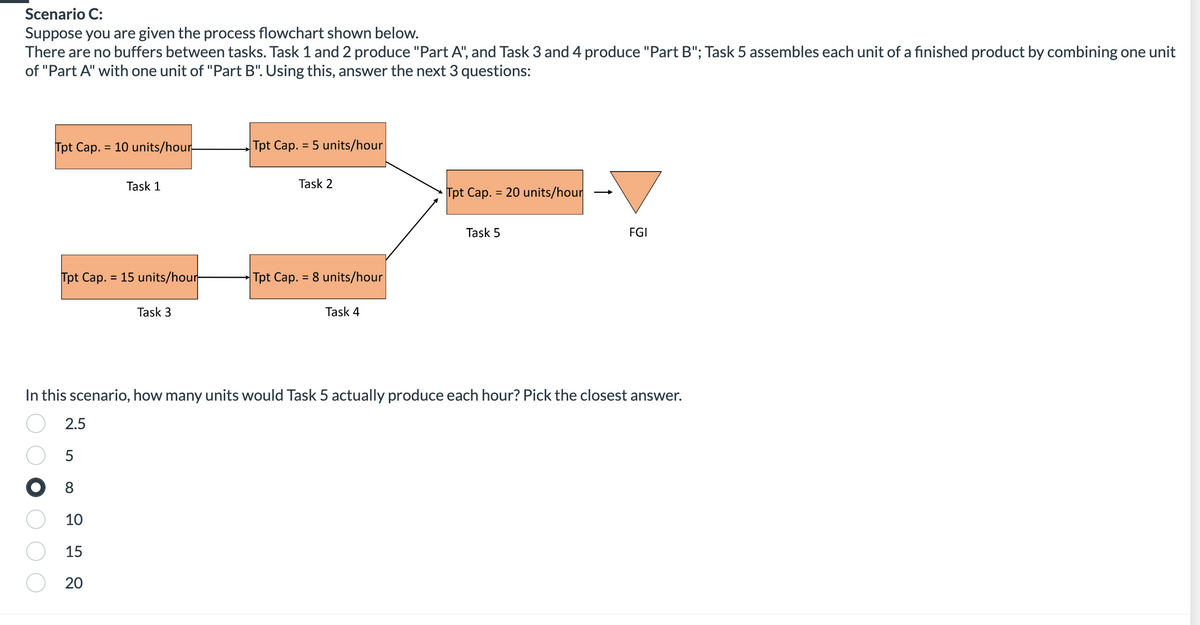Suppose you are given the process flowchart shown below. There are no buffers between tasks. Task 1 and 2 produce "Part A", and Task 3 and 4 produce "Part B"; Task 5 assembles each unit of a finished product by combining one unit of "Part A" with one unit of "Part B". Using this, answer the next 3 questions: Tpt Cap.= 10 units/hour O Task 1 Tpt Cap. 15 units/hour 2.5 5 8 10 15 20 Task 3 Tpt Cap. = 5 units/hour Task 2 Tpt Cap. = 8 units/hour Task 4 Tpt Cap. = 20 units/hour → Task 5 In this scenario, how many units would Task 5 actually produce each hour? Pick the closest answer. FGI
Suppose you are given the process flowchart shown below. There are no buffers between tasks. Task 1 and 2 produce "Part A", and Task 3 and 4 produce "Part B"; Task 5 assembles each unit of a finished product by combining one unit of "Part A" with one unit of "Part B". Using this, answer the next 3 questions: Tpt Cap.= 10 units/hour O Task 1 Tpt Cap. 15 units/hour 2.5 5 8 10 15 20 Task 3 Tpt Cap. = 5 units/hour Task 2 Tpt Cap. = 8 units/hour Task 4 Tpt Cap. = 20 units/hour → Task 5 In this scenario, how many units would Task 5 actually produce each hour? Pick the closest answer. FGI
Practical Management Science
6th Edition
ISBN:9781337406659
Author:WINSTON, Wayne L.
Publisher:WINSTON, Wayne L.
Chapter4: Linear Programming Models
Section: Chapter Questions
Problem 111P
Related questions
Question

Transcribed Image Text:Scenario C:
Suppose you are given the process flowchart shown below.
There are no buffers between tasks. Task 1 and 2 produce "Part A", and Task 3 and 4 produce "Part B"; Task 5 assembles each unit of a finished product by combining one unit
of "Part A" with one unit of "Part B". Using this, answer the next 3 questions:
Tpt Cap. = 10 units/hour-
Tpt Cap. = 15 units/hour
Task 1
5
● 8
10
15
20
Task 3
Tpt Cap. = 5 units/hour
Task 2
Tpt Cap. = 8 units/hour
Task 4
Tpt Cap. = 20 units/hour
Task 5
In this scenario, how many units would Task 5 actually produce each hour? Pick the closest answer.
FGI
Expert Solution
This question has been solved!
Explore an expertly crafted, step-by-step solution for a thorough understanding of key concepts.
This is a popular solution!
Trending now
This is a popular solution!
Step by step
Solved in 3 steps

Follow-up Questions
Read through expert solutions to related follow-up questions below.
Follow-up Question
a) Refer to Scenario C:
Which task(s) would be blocked? Check all that apply.
Task 1
Task 2
Task 3
Task 4
Task 5
b) Refer to Scenario C. What would the utilization of Task 3 be? Pick the closest answer.
10%
20%
30%
40%
50%
60%
70%
80%
90%
100%
c) Suppose you are given the same process as Scenario C, except with buffers between each of the tasks (shown attached). Buffers have no limit to the number of items they can potentially hold.
Suppose each buffer shaded in blue starts with 35 units in inventory. After 3 hours, approximately how many finished units will Task 5 have produced? Pick the closest answer.
10
20
30
40
50
60

Transcribed Image Text:Tpt Cap. = 10 units/hour
Task 1
Tpt Cap. = 15 units/hour
Task 3
Tpt Cap. 5 units/hour
Task 2
Tpt Cap. 8 units/hour
Task 4
Tpt Cap. = 20 units/hour
Task 5
-
FGI
Solution
Recommended textbooks for you

Practical Management Science
Operations Management
ISBN:
9781337406659
Author:
WINSTON, Wayne L.
Publisher:
Cengage,

Practical Management Science
Operations Management
ISBN:
9781337406659
Author:
WINSTON, Wayne L.
Publisher:
Cengage,